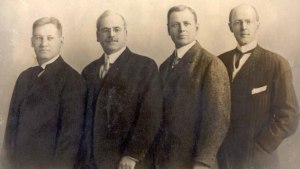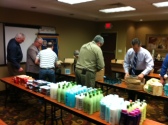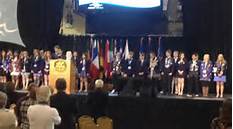
English: Rotaract Club of Chatswood 1989, winning the “Rotaraction Award”. Ryde, Sydney, Australia. June 1989. Rotary District 9680 Category:Rotary International (Photo credit: Wikipedia)
I last talked about the first day of what I would like to see in a District Conference. You might remember that we ended the day in one of the hospitality suites socializing with our new friends. Now that everyone is settled, you need to concentrate on keeping your staff energized and assaulting the senses of those in attendance. Although this agenda covers an entire convention day, it can either feel like a few hours to those who are participating and having fun, or it can seem like a week to those who are bored. Here’s what I think Saturday should look like:
DISTRICT CONFERENCE 2014
Saturday, April 26, 2014
7:30 a.m. Breakfast (House of Friendship opens)
Breakfast is presented in the House of Friendship. It is open for everyone. It is a good time to recognize Past District Governors, Rotary Alumni, and other “dignitaries.” The program should be minimal. It is NOT a regular Rotary Club meeting. Allow attendees to mingle while they eat and, if the weather cooperates, allow them to go outside too.
9:00 a.m. Saturday morning Sessions – Youth Services
These should be the sessions where you highlight your Youth Programs. Somewhere you will want to have a break. Do not keep your audience “captive” for three full hours! However, you should present your Youth Exchange participants, RYLA program, Interact and Rotaract clubs and any other youth events.
I have seen Youth Exchange students who can’t or won’t get up and talk. They are teens thrust in front of a crowd of older people. Don’t make them uncomfortable! The best Youth Exchange presentation I saw was a moderated panel discussion. Both inbound and outbound participants were seated on a stage. A Rotarian moderator walked around with a microphone and asked questions. She was able to get everyone to respond. Then, questions were asked from the audience and members of the panel were able to volunteer to answer. It was interesting and entertaining, mainly due to the skills of the moderator.
We have a great RYLA camp in our District. Many clubs take part in it financially. However, few Rotarians actually come to see the camp. Therefore, a part of the morning session could be devoted to having campers and staff talk about RYLA and what it means to them and to also explain to Rotarians how they can get involved.
The Interact and Rotaract Clubs should be asked to give a presentation. They can have ten to fifteen minutes to tell attendees about Interact or Rotaract and how Rotarians can get involved. Depending on the group, you may also want to have a moderator to help them. However, give them a chance to impress you! They can put on a skit, show a slide show about their projects, or have some of their members talk about their experiences. The goal is for the Rotarians to see these clubs in action and then meet their members and connect with them.
Our District annually does a two-week exchange with a District in Japan, called “Wings of Rotary.” It is a longstanding program in our District and one of which I am very proud. The Conference needs to hear from the participants in this program and see photos and videos of their experiences.
12:00 Luncheon
The luncheon should really be a Rotary meeting. Conduct it like a meeting and allow the President’s Representative to make his or her talk. If they gave their talk the night before at the evening program, you can offer them a chance to speak again, or have another interesting speaker (Please! Stay away from political speakers!). A way I found to increase attendance for this event is to ask each club to bring their club bell and have their presidents at the front of the room so that each can convene their club meeting. This gives each club a sense of pride in seeing their club and their club’s banner in the room, and allows you to get more attendees. You can continue the expansiveness of this meeting by having a parade of flags. Allow the exchange students to carry in their flags. Have the Rotary International flag there too. Use a color guard to present both your country’s flag and your state flag (or flags, if your district covers more than one state or area), and have either the playing, singing, or other presentation of your national anthem or other patriotic song. Adjourn the meeting no later than 1:15 so that attendees will have some time to relax before going to the next session.
1:30 p.m. Saturday afternoon Sessions – The Rotary Foundation
This session should be more than just a report on money raised and a request for more. I believe most Rotarians only remember those parts of Foundation presentations. Rather, these two hours should be spent with meaningful presentations on what the Foundation can do and how your Rotarians can participate. Three of the best presentations I have EVER heard in my Rotary experience have come at Zone Institutes. One was a young woman who had been a Rotary Peace Scholar in the Middle East. Her speech was riveting! Another, was a woman who came, dressed with her hat, vest, and megaphone, and talked about going on a National Immunization Day. Finally, the third presentation was from a Past District Governor who talked about taking his teenage daughter to Haiti for the dedication of some water wells their District provided. Everyone in the audience was choking back tears as he finished! You want – and NEED – presentations that inspire – not just report. Find those and bring them to your District. Once you inspire attendees, you can end the Sessions with a short presentation on how Rotarians can help the Foundation. In summary, show them the needs and successes before you ask for money.
1:30 p.m. Family Activities!
Remember: You will have spouses and children attending with their Rotarian. Most likely, those “others” will not want to sit in a room and listen to Rotary presentations. Give them activities and events in which to take part. You can arrange for a cooking class, walking tour, or a trip to a local landmark or event. You should also offer “kid friendly” activities such as a painting station or game room. Include a snack bar with these rooms. Remember, if you get the family members to enjoy the conference, it is more likely the Rotarian will return next year! Just make sure you get them all back to the conference site and get the kids cleaned before dinner!
3:30 p.m. Afternoon “Coffee Break”
This should be a slightly different kind of coffee break. The room should be set up with round tables, each of which can hold six to eight people. Each table should be assigned a different theme, in the form of a sign above it. They might be “Service Projects,” “RYLA,” “District Grants,” and “Wings of Rotary.” Then, as people enter, they will be asked to go get a drink and sit at a table to discuss the assigned topics. Each table will have a moderator. Then, every ten minutes, a horn will sound and everyone must move to another table. It will be pointed out that, at some time, everyone will be asked to stop and there will be a drawing for a prize. Only those seated at a table when the “stop” command is given will be eligible. The drawing will be an announcement of one of the subjects being discussed. Then, only participants at that subject’s table will be allowed to draw for the actual prize. The purpose is to get people in the room, get them engaged in participating in the event (hopefully, they will learn something while waiting for the drawing) and then get someone to leave with a nice prize. If available, you can do two or more drawings during the break.
4:30 p.m. Rotary Games
Even though we just finished having some “fun” in the Coffee Break, I am sure most attendees will be mentally and physically exhausted from the day. They’ve learned all they want to learn! This is where a Rotary game or two might be good. I have traveled to clubs and presented two different Rotary trivia games and each has been well received. One is Rotary Baseball (if your country does not play baseball, you can develop the game using any other popular local sport). It is a series of questions taken from the Manual of Procedure or the ABCs of Rotary. It also includes local “pop culture” questions, just to make it more fun. With the baseball concept, there are two teams. The room is divided against each other. Each team has a “coach” who is the only one who can answer questions. However, the “team” can discuss their answers and that is where the fun is! The coach is left in that no-win situation of having to choose one of the answers that his or her team has been fighting over and, if they are wrong, they get to bear the wrath of their teammates! The questions are in separate baskets labeled “Singles,” “Doubles,” “Triples,” and “Home Runs”, just like the hits in baseball, getting progressively harder. If the team answers correctly, they advance that many bases. If they get it wrong, it is considered an out and when the team gets three outs, the other team is allowed to “bat.” The fun is that many of the questions are really impossible to answer…the first time. However, whether the correct answer is given by the coach, the announcer gives the correct answer and the question goes back into the basket. In other words, it is very likely it will be asked again and again. That’s where the learning happens!
The other game is similar to the popular television show, “Who Wants To Be a Millionaire?” It is called “Who Wants To Be A Paul Harris Fellow?” If available, the District, a Club or an individual can give points or money to make the winner a Paul Harris Fellow. The game involves one contestant who must answer a series of progressively harder questions to move up the board, hoping to get to the top and win a Paul Harris Fellow. If they miss, they lose, and another contestant is chosen by drawing. Much like the television game, the contestants have “lifelines” to use. They can use a 50-50 option, which allows the computer to remove two of the incorrect answers. There is a choice to “ask a friend.” This allows the contestant to ask someone in the audience to help answer the question. Nevertheless, as the game advances, the tension in the room increases as the contestant gets closer to the top. Once again, the questions repeat. So, a later contestant might have a better chance of getting to the top and winning the prize.
The games should all end by 5:30 so that the attendees will have time to get to their rooms, change, and get ready for the evening part of the Conference program.
6:00 p.m. Buses leave for Saturday extravaganza
The evening event should be kept under wraps as much as possible. Let it be a surprise for everyone! There should be chartered buses to take attendees to the venue for dinner and entertainment, and then be available for return to the Conference site, as they refill.
6:30 p.m. Dinner and entertainment
The Chuckwagon Feast I described for Friday night could be this event, substituting a dinner at the Conference venue for Friday night. On the other hand, you could have the feast on Friday, and then take everyone to another venue for this Saturday meal. It could be a dinner theatre, a museum, or another outdoor venue. Whatever it is, it needs to have a WOW factor!
8:30 p.m. Return to Conference hotel (Hospitality suite opens)
Since everyone will have had a full day of activity, they will want to relax and have a drink (again!). Most likely, the activity in the hospitality suites will wind down earlier. However, since it is also the last night of the Conference, friends might enjoy spending more time together. Possibly assign two or more clubs to “host” the hospitality suites and provide entertainment or interesting snacks or other “eye-openers.”
This will be the hardest day of the Conference, since it is the longest. You must find a way to entertain your attendees, knowing that some may tire early, some may be overwhelmed with new information received, and some might be bored. It will be challenge. However, with careful planning, this could also be the day your attendees realize coming to this Conference was the right decision!







